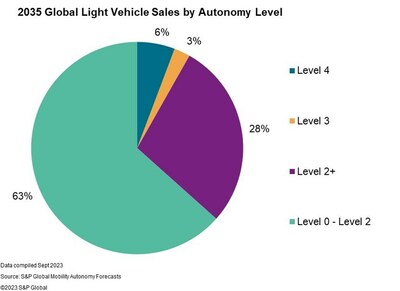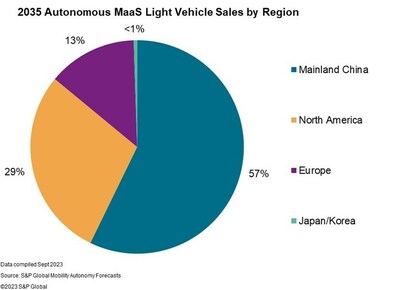Autonomous Vehicle Reality Check: Widespread Adoption Remains at Least a Decade Away, according to S&P Global Mobility
- At least 31% of new vehicle sales globally by 2035 will have Level 2+ and Level 3 systems
- Opportunity for automated driving systems in Level 2+ and Level 3 technologies
- Fewer than 6% of light vehicles sold in 2035 will have Level 4 functionality
- Widespread adoption of autonomous technology not expected within the next decade
The era of peak hype has passed, but forecasters still see long-term adoption in certain segments that benefit from today's rise in automated driving technology
For the next decade, autonomous tech will be limited to two specific areas: geofenced robotaxis operated by fleets in specific areas, and hands-off systems with various safeguards in personal vehicles that will still require some form of driver engagement.
The latest forecast from S&P Global Mobility notes that Level 5 Autonomy – "A vehicle that can go anywhere and do everything a human driver can," will not be publicly available before 2035, "and probably for some time after that," stated Jeremy Carlson, associate director for the autonomy practice at S&P Global Mobility. "But the outlook for more targeted implementations of the same fundamental technologies, especially in Level 2+ and Level 3 but also for some forms of Level 4, is more positive and will certainly happen on a much shorter timeline."
This latest outlook from S&P Global Mobility reflects the headwinds and slower pace of development that both the automotive and tech industries have demonstrated over the past several years. It paints a stark contrast to the optimism of just five years ago when the world was swept up in the promise and excitement of a future of self-driving vehicles in Levels 4 and 5. Now, S&P Global Mobility presents a more realistic outlook amid this moderated pace of progress while also publishing new data on the intersection of autonomy and mobility-as-a-service (MaaS).
Automated – rather than autonomous – driving continues to be the focus of industry development. Today's broad deployments of Level 2+ and Level 3 systems by many automakers in multiple regions will reach at least
"There is immense opportunity for automated driving systems in L2+ and L3, and they are benefiting from the standardization of basic safety features which provide a foundation of in-vehicle architecture, sensing, and compute," Carlson says. "Their functionality also complements driving today rather than fully replacing the driver, making consumer adoption less of a challenge. The next several years of wider deployment across brands and vehicle platforms will be a boon for automakers selling these optional features as well as suppliers who continue to build scale and a strong foundation for the future."
L4 Technology Slow to Develop in Personal Vehicles – MaaS Robotaxis to Lead the Way
The S&P Global Mobility forecast predicts fewer than
There are positive examples of autonomous vehicles performing as well as humans in today's pilot programs in places like
Mobility-as-a-Service (MaaS) and robotaxis are nonetheless expected to lead the transition to an autonomous vehicle future, even with the relatively cautious growth ahead. There are growing numbers of small-scale deployments in certain cities around the world. But S&P Global Mobility forecasters do not expect that to become widespread and broadly accessible within the next decade.
MaaS-equipped vehicles and robotaxi applications are expected to represent less than 800,000 vehicles sold globally in 2035. Robotaxis will be carefully geofenced for the foreseeable future – offering revenue service only within specific areas where they have already been extensively tested, Carlson predicts. But their high rate of utilization can be nonetheless effective at bringing new mobility options to some consumers and new revenue streams to automakers and mobility providers.
Owen Chen, senior principal analyst from S&P Global Mobility, explains that robotaxi development and commercialization is a complex and multi-stage process which can be summarized in three stages. First, technical feasibility demonstrations confirm that robotaxis can operate safely and reliably in the targeted conditions. Second, the long process of technology optimization, integration, and refining vehicle design eventually brings scale to manufacturing and deployment. Third is the efficient expansion to many new locations and operating conditions, with profit on top of revenue from meaningful adoption by consumers. Chen adds that, "In 2023, many are working through stage 1 while several are seeking scale in stage 2, led by Mainland China and the US. But the opportunity to restructure personal and shared mobility exists."
In August, the California Public Utility Commission approved an expansion of operations in
While the US captured an early lead in both development and deployment of L4 MaaS, Mainland China is expected to contribute the greatest volumes long-term, followed by the US and
Challenges nonetheless remain for successful and widespread deployment of L4 MaaS. In addition to a fragmented regulatory landscape and relatively low public trust that may hamper consumer acceptance and adoption, the cost of technology and the time needed for robust development and validation of hardware and software have quashed the optimism that defined much of the last decade.
Reduced complexity in L2+ and L3 features face less risk or uncertainty for each of these factors, hence the more positive outlook for those technologies in the short term. This optimism is further boosted as some regulators are also mandating certain basic safety assistance features that will generate even wider exposure for selective automation.
Automakers, suppliers, technology companies and mobility providers alike, however, remain committed to a future of safe and equitable autonomous mobility, even if it takes more time to get there.
"There's plenty of opportunity and growth ahead," says Carlson. "Significant volumes measured in the hundreds of thousands per year are quite likely to come before 2030—but a future of shared mobility everywhere all the time will remain an aspiration for the industry."
For the full report, click here.
About S&P Global Mobility
At S&P Global Mobility, we provide invaluable insights derived from unmatched automotive data, enabling our customers to anticipate change and make decisions with conviction. Our expertise helps them to optimize their businesses, reach the right consumers, and shape the future of mobility. We open the door to automotive innovation, revealing the buying patterns of today and helping customers plan for the emerging technologies of tomorrow.
S&P Global Mobility is a division of S&P Global (NYSE: SPGI). S&P Global is the world's foremost provider of credit ratings, benchmarks, analytics and workflow solutions in the global capital, commodity, and automotive markets. With every one of our offerings, we help many of the world's leading organizations navigate the economic landscape so they can plan for tomorrow, today. For more information, visit www.spglobal.com/mobility.
Media Contact:
Michelle Culver
S&P Global Mobility
248.728.7496 or 248.342.6211
Michelle.culver@spglobal.com
![]() View original content to download multimedia:https://www.prnewswire.com/news-releases/autonomous-vehicle-reality-check-widespread-adoption-remains-at-least-a-decade-away-according-to-sp-global-mobility-301937079.html
View original content to download multimedia:https://www.prnewswire.com/news-releases/autonomous-vehicle-reality-check-widespread-adoption-remains-at-least-a-decade-away-according-to-sp-global-mobility-301937079.html
SOURCE S&P Global Mobility










